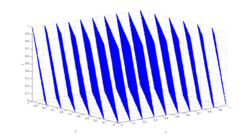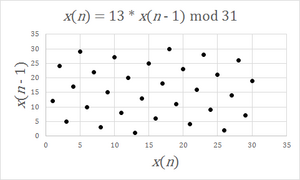Spectral test

The spectral test is a statistical test for the quality of a class of pseudorandom number generators (PRNGs), the linear congruential generators (LCGs).[1] LCGs have a property that when plotted in 2 or more dimensions, lines or hyperplanes will form, on which all possible outputs can be found.[2] The spectral test compares the distance between these planes; the further apart they are, the worse the generator is.[3] As this test is devised to study the lattice structures of LCGs, it can not be applied to other families of PRNGs.
According to Donald Knuth,[4] this is by far the most powerful test known, because it can fail LCGs which pass most statistical tests. The IBM subroutine RANDU[5][6] LCG fails in this test for 3 dimensions and above.
Let the PRNG generate a sequence [math]\displaystyle{ u_1, u_2, \dots }[/math]. Let [math]\displaystyle{ 1/\nu_t }[/math] be the maximal separation between covering parallel planes of the sequence [math]\displaystyle{ \{(u_{n+1:n+t}) | n = 0, 1, \dots\} }[/math]. The spectral test checks that the sequence [math]\displaystyle{ \nu_2, \nu_3, \nu_4, \dots }[/math] does not decay too quickly.
Knuth recommends checking that each of the following 5 numbers is larger than 0.01.[math]\displaystyle{ \begin{aligned} \mu_2 &= \pi \nu_2^2 / m, & \mu_3 &= \frac{4}{3} \pi \nu_3^3 / m, & \mu_4 &= \frac{1}{2} \pi^2 \nu_4^4 / m \\[1ex] && \mu_5 &= \frac{8}{15} \pi^2 \nu_5^5 / m, & \mu_6 &= \frac{1}{6} \pi^3 \nu_6^6 / m \end{aligned} }[/math]where [math]\displaystyle{ m }[/math] is the modulus of the LCG.
Examples
Examples from [4], especially Table 1 and discussions following it.
A small variant of the infamous RANDU, with [math]\displaystyle{ x_{n+1} = 65539 x_n \bmod 2^{29} }[/math] has [math]\displaystyle{ \mu_i = 3.14, 10^{-5}, 10^{-4}, 10^{-3}, 0.02 }[/math][math]\displaystyle{ \nu^2_i = 536936458, 118, 116, 116, 116 }[/math]
where [math]\displaystyle{ i = 2, 3, 4, 5, 6 }[/math].
George Marsaglia considers [math]\displaystyle{ x_{n+1} = 69069 x_n \bmod 2^{32} }[/math] as "a candidate for the best of all multipliers" because it is easy to remember, and has particularly large spectral test numbers:[7]
[math]\displaystyle{ \nu^2_i = 4243209856, 2072544, 52804, 6990, 242 }[/math]
References
- ↑ Williams, K. B.; Dwyer, Jerry (1 Aug 1996), "Testing Random Number Generators, Part 2", Dr. Dobb's Journal, http://drdobbs.com/184403208, retrieved 26 Jan 2012.
- ↑ "Random Numbers Fall Mainly in the Planes". PNAS 61 (1): 25–28. September 1968. doi:10.1073/pnas.61.1.25. PMID 16591687. PMC 285899. Bibcode: 1968PNAS...61...25M. https://www.pnas.org/content/61/1/25.full.pdf.
- ↑ Jain, Raj. "Testing Random-Number Generators (Lecture)". http://www.cse.wustl.edu/~jain/cse567-08/ftp/k_27trg.pdf. Retrieved 2 December 2016.
- ↑ 4.0 4.1 Knuth, Donald E. (1981), "3.3.4: The Spectral Test", The Art of Computer Programming volume 2: Seminumerical algorithms (2nd ed.), Addison-Wesley.
- ↑ IBM, System/360 Scientific Subroutine Package, Version II, Programmer's Manual, H20-0205-1, 1967, p. 54.
- ↑ ((International Business Machines Corporation)) (1968). "IBM/360 Scientific Subroutine Package (360A-CM-03X) Version III". Stan's Library (White Plains, NY: IBM Technical Publications Department) II: 77. doi:10.3247/SL2Soft08.001. Scientific Application Program H20-0205-3. http://www.ebyte.it/library/downloads/IBM_System360_SSP.pdf#page=81.
- ↑ Marsaglia, GEORGE (1972-01-01), Zaremba, S. K., ed., "The Structure of Linear Congruential Sequences", Applications of Number Theory to Numerical Analysis (Academic Press): pp. 249–285, ISBN 978-0-12-775950-0, https://www.sciencedirect.com/science/article/pii/B9780127759500500133, retrieved 2024-01-29
 |



